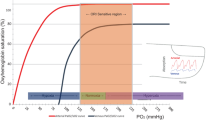Abstract
Cyanosis was used for a century after dentists began pulling teeth under 100% N2O in 1844 because brief (2 min) severe hypoxia is harmless. Deaths came with curare and potent anesthetic respiratory arrest. Leland Clark’s invention of a polarographic blood oxygen tension electrode (1954) was introduced for transcutaneous PO2 monitoring to adjust PEEP and CPAP PO2 to prevent premature infant blindness from excess O2 (1972). Oximetry for warning military aviators was tried after WW II but not used for routine monitoring until Takuo Aoyagi (1973) discovered an equation to measure SaO2 by the ratio of ratios of red and IR light transmitted through tissue as it changed with arterial pulses. Pulse oximetry (1982) depended on simultaneous technology improvements of light emitting red and IR diodes, tiny cheap solid state sensors and micro-chip computers. Continuous monitoring of airway anesthetic concentration and oxygen also became very common after 1980. Death from anesthesia fell 10 fold between 1985 and 2000 as pulse oximetry became universally used, but no proof of a causative relationship to pulse oximetry exists. It is now assumed that all anesthesiologist became much more aware of the dangers of prolonged hypoxia, perhaps by using the pulse oximeters.
Similar content being viewed by others
References
Robinson V. Victory over pain, Henry Schurman: New York; 1946. p. 338.
Comroe JH, Botelho S. The unreliability of cyanosis in the recognition of arterial anoxemia. Am J Med Sci. 1947;124:1–6.
Beecher HK, Todd DP. A study of the deaths associated with anesthesia and surgery. Ann Surg. 1954;124:2–34.
Kirchhoff GR RWEB. Chemische Analyse durch Spectralbeobachtungen. Engelmann: Leipzig; 1860. p. 1–98.
Stokes GG. On the reduction and oxygenation of the colouring matter of the blood. Proc Royal Soc. 1864;XIII:355–64.
Hoppe-Seyler F. Über das Verhalten des Blutfarbstoffes im Spektrum des Sonnenlichtes. Arch Path Anat Physiol. 1862;23:446–9.
Vierordt K. Die quantitative Spektralanalyse in ihrer Anwendung auf Physiologie, Physik, Chemie und Technologie. Tübingen, H. Laupp’sche Buchhandlung; 1876.
Kramer K. Ein Verfahren zur fortlaufenden Messung des Sauerstoffgehaltes im stromenden Blute an uneroffneten Gefassen. Z Biol. 1935;96:61–75.
Matthes K, Gross F. Untersuchunger uber die Absorption von rotem und ultraotem Licht durch kohlenoxydesattigtes und reduziertes Blut. Arch Exp Pathol Pharmacol. 1939;191:369–90.
McClure RD, et al. Anoxia-A source of possible compliations in surgical anesthesia. Ann Surg. 1939;110:835–50.
McClure RD, Behrmann VG, Hartman FW. The control of anoxemia during surgical anesthesia with the aid of an oxyhemograph. Ann Surg. 1948;128:685–707.
Millikan GA. The oximeter: an instrument for measuring continuously oxygen saturation of arterial blood in man. Rev Sci Instr. 1942;13:434–44.
Faulconer A, Pender JW, Bickford RG. The influence of partial pressure of nitrous oxide on the depth of anesthesia and the electroencephalogram in man. Anesthesiol. 1949;10:601–9.
Wood EH, Geraci JE. Photoelectric determination of arterial oxygen saturation in man. J Lab Clin Med. 1949;34:387–401.
Brinkman R, Zijlstra WG, Koopmans RK. A method for continuous observation of percentage oxygen saturation in patients. Arch Chir Neerl. 1950;1:333–44.
Stow RW, Randall BF. Electrical measurement of the PCO2 of blood. Am J Physiol. 1954;179:678. (abs).
Clark LC. Measurement of oxygen tension: a historical perspective. Crit Care Med. 1981;9:960–2.
Severinghaus JW, Bradley AF. Electrodes for blood PO2 and PCO2 determination. J Appl Physiol. 1958;13:515–20.
Baumberger JP, Goodfriend RB. Determination of arterial oxygen tension in man by equilibration through intact skin. Fed Proc. 1951;10:10. (abs).
Rooth G, Sjostedt S, Caligara F. Bloodless determination of arterial oxygen tension by polarography. Sci Tools LKW Instrum J. 1957;4:37–9.
Huch R, Lübbers DW, Huch A. Quantitative continuous measurement of partial oxygen pressure on the skin of adults and new-born babies. Pflügers Archiv. 1972;337:185–98.
Eberhard P, Hammacher K, Mindt W: Perkutane Messung des Sauerstoffpartialdruckes. Methodik und Anwendungen. Proc “Medizin-Technik 1972”. 1972; 26.
Palmisano BW, Severinghaus JW. Transcutaneous PCO2 and PO2: a multicenter study of accuracy. J Clin Monit. 1990;6:189–95.
Squire JR. Instrument for measuring quantity of blood and its degree of oxygenation in web of the hand. Clin Sci. 1940;4:331–9.
Goldie EAG. A device for the continuous indication of oxygen saturation of circulating blood in man. J Sci Instrum. 1942;19:23–5.
Wood EH. Oximetry, In: O Glasser editor. Medical Physics. Chicago: Year Book Publishers, Inc.; 1950. vol 2, p. 664–680.
Severinghaus JW. Takuo Aoyagi: discovery of pulse oximetry. Anesth Analg. 2007;105:S1–4.
Nakajima S, Hirai Y, Takase H. Performances of new pulse wave earpiece oximeter. Respir Circ. 1975;23:41–5.
Sarnquist FH, Todd C, Whitcher C. Accuracy of a new non-invasive oxygen saturation monitor. Anesthesiology. 1980;53:S163.
Yelderman M, New WJ. Evaluation of pulse oximetry. Anesthesiology. 1983;59:349–52.
Payne JP, Severinghaus JW. Pulse oximetry. Springer: Heidelberg; 1986. p. 193.
Tinker JH, et al. Role of monitoring devices in prevention of anesthetic mishaps: a closed claims study. Anesthesiology. 1989;71:541–6.
Moller J, et al. Randomized evaluation of pulse oximetry in 20, 802 patients: I. Design, demography, pulse oximetry failure rate, and overall complication rate. Anesthesiology. 1993;78:436–44.
Author information
Authors and Affiliations
Corresponding author
Additional information
Severinghaus JW. Monitoring oxygenation.
Rights and permissions
About this article
Cite this article
Severinghaus, J.W. Monitoring oxygenation. J Clin Monit Comput 25, 155–161 (2011). https://doi.org/10.1007/s10877-011-9284-2
Received:
Accepted:
Published:
Issue Date:
DOI: https://doi.org/10.1007/s10877-011-9284-2




